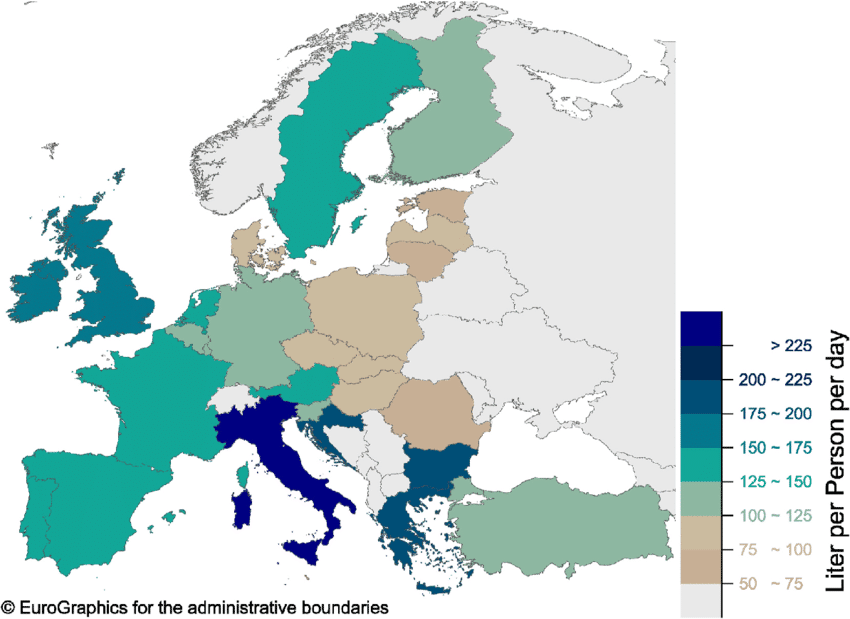Much of the water we use every day is obvious and visible, whether it is water use in our homes, schools or places of work. Water use in our homes – such as flushing toilets, cooking, and showering – is known as domestic water use or domestic consumption.
On average, our domestic water consumption is 150 litres a day per person.

However, our domestic consumption is only a small amount of the total amount of water we actually use every day, when we take into account all the water that is required to make so many of the products we consume daily from our clothing and cosmetics to our food and drinks.
This is considered to be our ‘hidden’ water use – also known as ‘virtual’ water use. Combined, our domestic and hidden water use makes up our water footprint.
“Hidden water” makes up the majority of our daily water use.
While the recent drought and water restrictions in Ireland have brought our daily direct water use into focus, increasingly hidden water use is becoming a topical issue across many industries. It is now time for us as individuals to not only reduce our direct or visible water usage but to also look at adjusting our lifestyles to reduce the virtual ways we use water.
Knowing how much water it takes to produce so many of the things we own and use in our daily lives is the first step to finding ways of reducing our overall water footprint.
Fashion industry
When we think about the fashion industry and its environmental impact we usually think about carbon emissions in the supply chain and production processes. But what about the impact of the fashion industry on water?
Cotton is one of the world’s thirstiest crops and is a heavy water polluter. Cotton accounts for 90% of all natural fibres used in the textile industry. This crop is used in about 40% of the world’s clothing.
Did you know that it takes 10,000 litres of water to grow one kilo of cotton needed to produce just one pair of jeans? In comparison, one person would take 10 years to drink 10,000 litres of water.
Cotton T-shirts require approximately 2,700 litres of water to produce. That’s enough drinking water to last a person 900 days.
Food production

Our food consumption makes up the largest part of our overall water footprint. It is estimated that it takes almost 3,500 litres of water to produce our daily food consumption. The more processes in the production process, the more water required.
Diets that include large amounts of dairy and meat products will have a larger footprint than diets that are higher in vegetables and grains. So for example, to produce 1kg of beef requires 13,500 litres of water. Hard to visualise? Think of a one-litre bottle of water. Now imagine 13,500 of those water bottles!
One beef burger alone requires 2,400 litres to produce.
Coffee aficionados have a high virtual water usage rate. It might come as a surprise, but coffee requires even a higher volume of water to produce, needing almost 19,000 litres of water to produce 1 kg of coffee beans. Coffee is almost seven times thirstier than tea to produce.
We waste about a third of all of the food we purchase, essentially one in every three bags of food shopping goes in the bin. This results in both food and water waste. In terms of water, this relates to the water used to produce the food. Therefore, adjusting your shopping list to ensure that you are not purchasing excess food save waters.
What can you do?
To reduce our water footprint the solution lies in the choices we make every day as consumers.
Have you seen #meatfreemonday on your Instagram feed? This is more than just tokenship. We can cut our water footprint by a third every time we eat a vegetarian meal.
By eating one less meat meal per week, we could save 2,500 litres of water per person per day.
Often it is simple solutions and effortless changes that have the most profound impact on the environment. Sustainable behaviour is not rocket science or just for the experts. It is something we can all do, all of the time, with little time or effort required.
If you’re passionate about fashion, it is worth reusing and upcycling clothes. This saves water, lessens the number of clothes ending up in a landfill, and saves you money. Our organisation empowers people to make sustainable lifestyle choices through small shifts in behaviour.
Also read:
